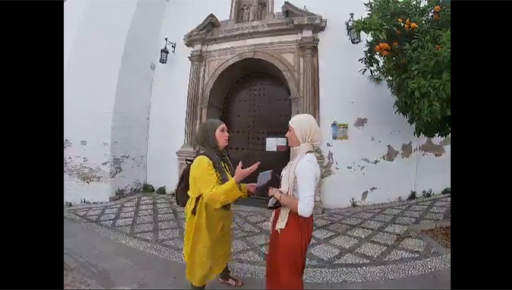1 The finished product: examples of docutubes
There are a wide range of approaches young people can take in their docutubes. In the ‘Plan’ session of this course, you saw examples of docutubes made by young people in Warsaw and London. You are now going to see some further examples of docutubes that young people have made in the context of the RETOPEA pilot workshops. These will help to give you a clearer idea of what docutubes could look like. It is important to stress, though, that there is no such thing as an ‘ideal’ or ‘perfect’ docutube, so these examples shouldn’t be regarded as blueprints.
Activity 1
Watch the following three examples of docutubes, which illustrate the wide variety of different approaches that young people who have taken part in the pilot workshops have adopted. As you watch, make notes in the text box below on the differences and similarities between these docutubes, bearing in mind the following questions:
- How do these docutubes engage with issues of religious toleration and peace in the past and present?
- How do these docutubes reflect the participants’ different local environments and experiences?

Transcript: Video 1
[MUSIC PLAYING]
[TEXT ON SCREEN: Are we becoming less tolerant of people wearing religious symbols?]
[MUSIC PLAYING]
[MUSIC PLAYING]
[TEXT ON SCREEN:Shirley Chaplin lost her case against the European Court of Human Rights. The court ruled that her rights had not been violated under the ECHR.]
[TEXT ON SCREEN: Who decides what religious symbols and expressions are acceptable?]
[MUSIC PLAYING]
[TEXT ON SCREEN: How would you feel if you had experienced any religious discrimination. What would you do about it?]

Transcript: Video 2 (a translation of this video is available in the transcript)
[TEXT ON SCREEN: ¿Dónde está la Meca?]
[TEXT ON SCREEN: Where is Mecca?]

Transcript: Video 3
[TEXT ON SCREEN: We wanted to find out what Finnish people think about religious tolerance. How do you think different religions are treated in Finland?]
[TEXT ON SCREEN: Do you believe that religion, peace and tolerance fit together?]
[TEXT ON SCREEN: Thank you for all participants and thank you for watching.]
Discussion
You might have picked up on a wide range of things, as these docutubes are quite different from one another! Here are a couple of things you might have noted:
Some of these differences are due to the fact that the young people who made these films have related the ideas they encountered in the RETOPEA materials to their own local environment in a range of different ways. Some consider wider social and legal issues, for example in relation to the display of religious symbols – or re-enact historical situations, illustrating examples of religious toleration or intolerance. In some examples, the link between the past and present is explored more explicitly, and others highlight issues relevant to religious toleration and peace more clearly.
This first docutube, made by a group of young people in London, engages with a number of RETOPEA clippings, including a clipping based on the European Convention of Human Rights [Tip: hold Ctrl and click a link to open it in a new tab. (Hide tip)] as well as a clipping about clothing rules for Muslims and Christians issued by Caliph Umar. The students have used a wide variety of different filming techniques and props, including drawings, photos and voice recordings, to highlight different issues related to the right of religious expression, and the display of religious symbols through clothing and jewellery in particular. This film begins with some brief references to the historical and legal context, but focuses mainly on how these issues are relevant to contemporary society.
In the second docutube, young people from a community group engage very much with their local religious history in the Spanish city of Granada. This film involves a combination of different techniques, including expository (presenting a number of different local places and historical facts), participatory (for example, with one of the filmmakers trying on a hijab), as well as performative (with some filmmakers acting, for instance, like they are looking for a mosque or burning books). The starting point for these young people was the RETOPEA clipping about the Reconquista. While the key message is perhaps not wholly clear, this docutube works well visually, taking advantage of the location.
The third docutube was made by a group of teenagers in Tampere, Finland. This is based on a set of interviews with a teacher and students at their school. This film does not directly refer to a specific RETOPEA clipping but focuses on the interviewees’ perception of religious toleration and peace in contemporary Finland.
